Professional Practice Portfolio: Analysis and Discussion - NRS3806
VerifiedAdded on 2022/08/21
|9
|2394
|9
Report
AI Summary
This report examines the concept and application of a Professional Practice Portfolio (PPP) within the context of nursing practice. It begins by defining a PPP and outlining its essential components, emphasizing the importance of documenting learning, experiences, and supporting credentials. The report then argues for the use of PPPs, highlighting their role in self-reflection, professional development, and demonstrating competency to employers. It differentiates between management and leadership concepts, and how a PPP can be used to showcase these skills. The report includes an example of a student nurse's experience in an emergency department, discussing the application of professional standards as defined by the Nursing and Midwifery Board of Australia (NMBA), specifically focusing on assessment, safe practice, and critical thinking. The report concludes by analyzing the student's actions in the context of the NMBA standards, identifying areas of compliance and areas where improvements could have been made. It also includes a comprehensive list of references supporting the concepts discussed.
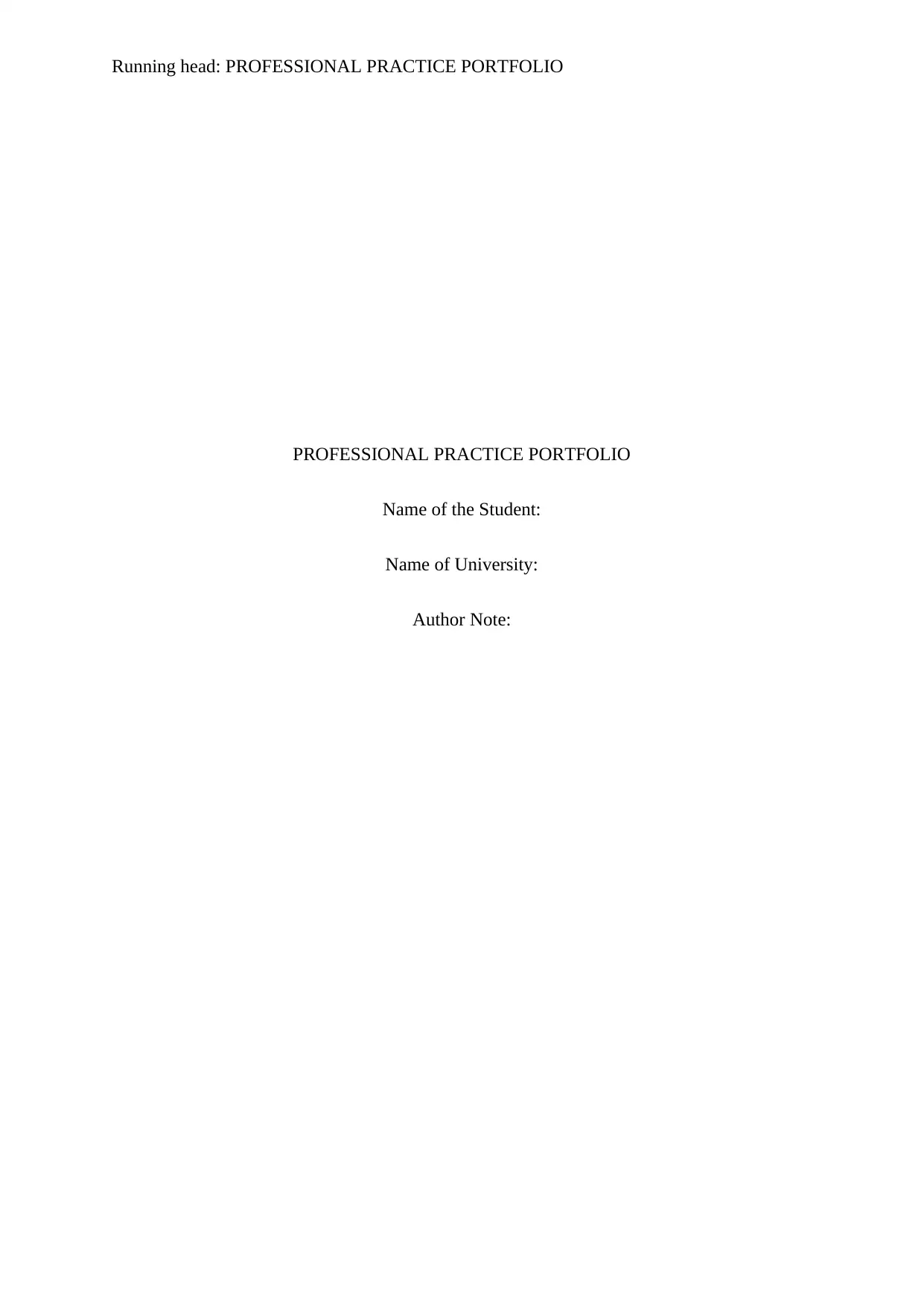
Running head: PROFESSIONAL PRACTICE PORTFOLIO
PROFESSIONAL PRACTICE PORTFOLIO
Name of the Student:
Name of University:
Author Note:
PROFESSIONAL PRACTICE PORTFOLIO
Name of the Student:
Name of University:
Author Note:
Paraphrase This Document
Need a fresh take? Get an instant paraphrase of this document with our AI Paraphraser
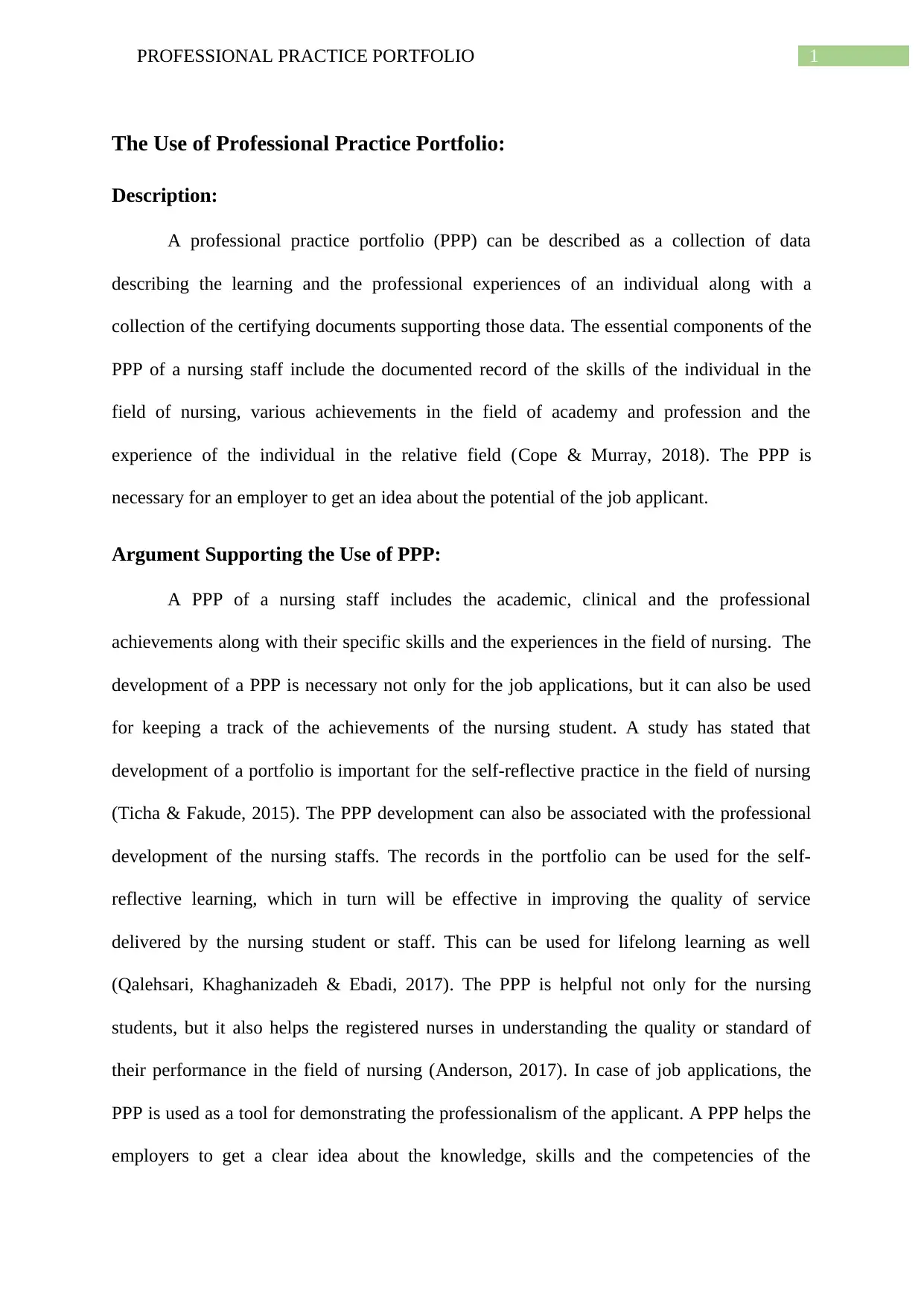
1PROFESSIONAL PRACTICE PORTFOLIO
The Use of Professional Practice Portfolio:
Description:
A professional practice portfolio (PPP) can be described as a collection of data
describing the learning and the professional experiences of an individual along with a
collection of the certifying documents supporting those data. The essential components of the
PPP of a nursing staff include the documented record of the skills of the individual in the
field of nursing, various achievements in the field of academy and profession and the
experience of the individual in the relative field (Cope & Murray, 2018). The PPP is
necessary for an employer to get an idea about the potential of the job applicant.
Argument Supporting the Use of PPP:
A PPP of a nursing staff includes the academic, clinical and the professional
achievements along with their specific skills and the experiences in the field of nursing. The
development of a PPP is necessary not only for the job applications, but it can also be used
for keeping a track of the achievements of the nursing student. A study has stated that
development of a portfolio is important for the self-reflective practice in the field of nursing
(Ticha & Fakude, 2015). The PPP development can also be associated with the professional
development of the nursing staffs. The records in the portfolio can be used for the self-
reflective learning, which in turn will be effective in improving the quality of service
delivered by the nursing student or staff. This can be used for lifelong learning as well
(Qalehsari, Khaghanizadeh & Ebadi, 2017). The PPP is helpful not only for the nursing
students, but it also helps the registered nurses in understanding the quality or standard of
their performance in the field of nursing (Anderson, 2017). In case of job applications, the
PPP is used as a tool for demonstrating the professionalism of the applicant. A PPP helps the
employers to get a clear idea about the knowledge, skills and the competencies of the
The Use of Professional Practice Portfolio:
Description:
A professional practice portfolio (PPP) can be described as a collection of data
describing the learning and the professional experiences of an individual along with a
collection of the certifying documents supporting those data. The essential components of the
PPP of a nursing staff include the documented record of the skills of the individual in the
field of nursing, various achievements in the field of academy and profession and the
experience of the individual in the relative field (Cope & Murray, 2018). The PPP is
necessary for an employer to get an idea about the potential of the job applicant.
Argument Supporting the Use of PPP:
A PPP of a nursing staff includes the academic, clinical and the professional
achievements along with their specific skills and the experiences in the field of nursing. The
development of a PPP is necessary not only for the job applications, but it can also be used
for keeping a track of the achievements of the nursing student. A study has stated that
development of a portfolio is important for the self-reflective practice in the field of nursing
(Ticha & Fakude, 2015). The PPP development can also be associated with the professional
development of the nursing staffs. The records in the portfolio can be used for the self-
reflective learning, which in turn will be effective in improving the quality of service
delivered by the nursing student or staff. This can be used for lifelong learning as well
(Qalehsari, Khaghanizadeh & Ebadi, 2017). The PPP is helpful not only for the nursing
students, but it also helps the registered nurses in understanding the quality or standard of
their performance in the field of nursing (Anderson, 2017). In case of job applications, the
PPP is used as a tool for demonstrating the professionalism of the applicant. A PPP helps the
employers to get a clear idea about the knowledge, skills and the competencies of the
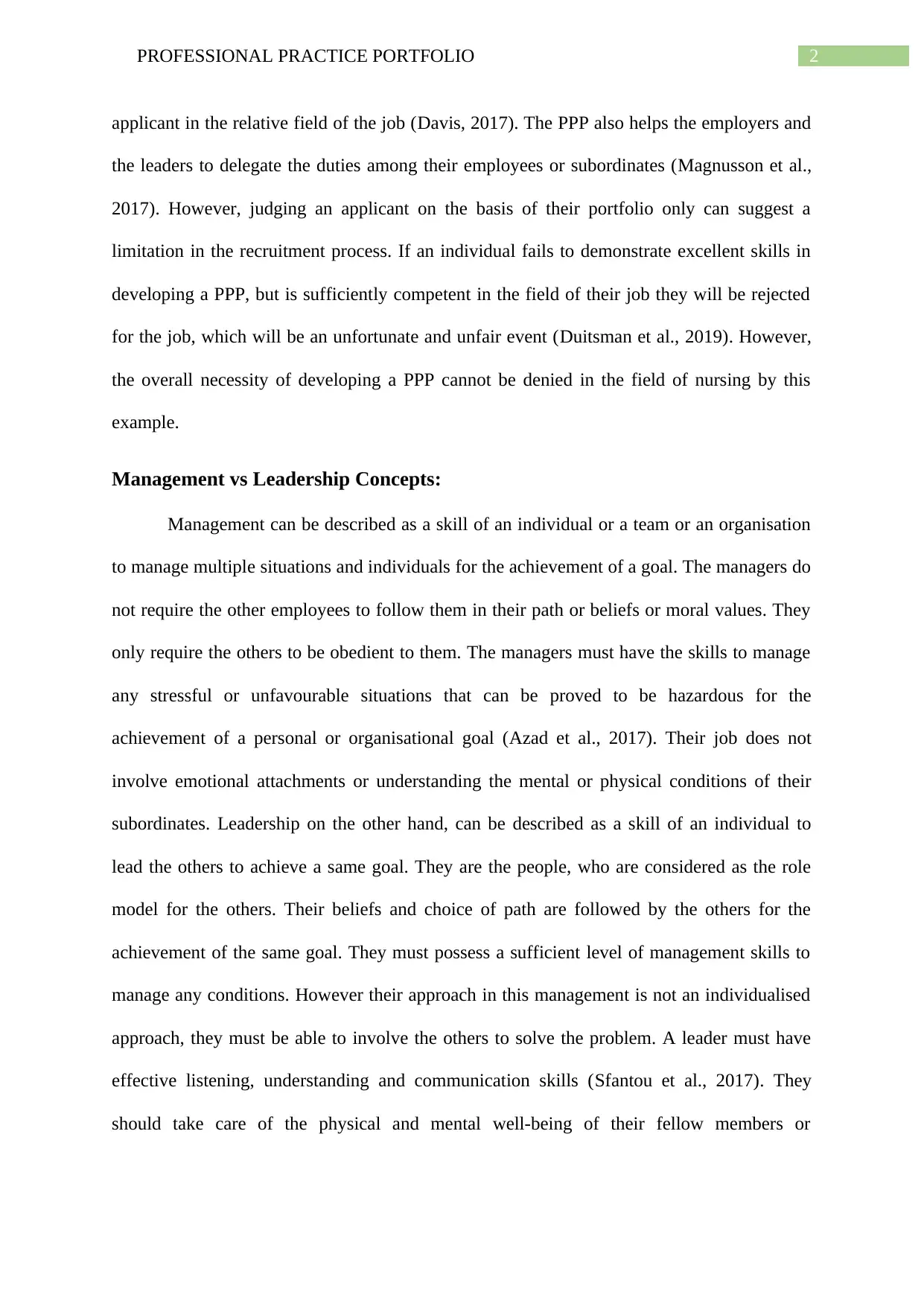
2PROFESSIONAL PRACTICE PORTFOLIO
applicant in the relative field of the job (Davis, 2017). The PPP also helps the employers and
the leaders to delegate the duties among their employees or subordinates (Magnusson et al.,
2017). However, judging an applicant on the basis of their portfolio only can suggest a
limitation in the recruitment process. If an individual fails to demonstrate excellent skills in
developing a PPP, but is sufficiently competent in the field of their job they will be rejected
for the job, which will be an unfortunate and unfair event (Duitsman et al., 2019). However,
the overall necessity of developing a PPP cannot be denied in the field of nursing by this
example.
Management vs Leadership Concepts:
Management can be described as a skill of an individual or a team or an organisation
to manage multiple situations and individuals for the achievement of a goal. The managers do
not require the other employees to follow them in their path or beliefs or moral values. They
only require the others to be obedient to them. The managers must have the skills to manage
any stressful or unfavourable situations that can be proved to be hazardous for the
achievement of a personal or organisational goal (Azad et al., 2017). Their job does not
involve emotional attachments or understanding the mental or physical conditions of their
subordinates. Leadership on the other hand, can be described as a skill of an individual to
lead the others to achieve a same goal. They are the people, who are considered as the role
model for the others. Their beliefs and choice of path are followed by the others for the
achievement of the same goal. They must possess a sufficient level of management skills to
manage any conditions. However their approach in this management is not an individualised
approach, they must be able to involve the others to solve the problem. A leader must have
effective listening, understanding and communication skills (Sfantou et al., 2017). They
should take care of the physical and mental well-being of their fellow members or
applicant in the relative field of the job (Davis, 2017). The PPP also helps the employers and
the leaders to delegate the duties among their employees or subordinates (Magnusson et al.,
2017). However, judging an applicant on the basis of their portfolio only can suggest a
limitation in the recruitment process. If an individual fails to demonstrate excellent skills in
developing a PPP, but is sufficiently competent in the field of their job they will be rejected
for the job, which will be an unfortunate and unfair event (Duitsman et al., 2019). However,
the overall necessity of developing a PPP cannot be denied in the field of nursing by this
example.
Management vs Leadership Concepts:
Management can be described as a skill of an individual or a team or an organisation
to manage multiple situations and individuals for the achievement of a goal. The managers do
not require the other employees to follow them in their path or beliefs or moral values. They
only require the others to be obedient to them. The managers must have the skills to manage
any stressful or unfavourable situations that can be proved to be hazardous for the
achievement of a personal or organisational goal (Azad et al., 2017). Their job does not
involve emotional attachments or understanding the mental or physical conditions of their
subordinates. Leadership on the other hand, can be described as a skill of an individual to
lead the others to achieve a same goal. They are the people, who are considered as the role
model for the others. Their beliefs and choice of path are followed by the others for the
achievement of the same goal. They must possess a sufficient level of management skills to
manage any conditions. However their approach in this management is not an individualised
approach, they must be able to involve the others to solve the problem. A leader must have
effective listening, understanding and communication skills (Sfantou et al., 2017). They
should take care of the physical and mental well-being of their fellow members or
⊘ This is a preview!⊘
Do you want full access?
Subscribe today to unlock all pages.

Trusted by 1+ million students worldwide
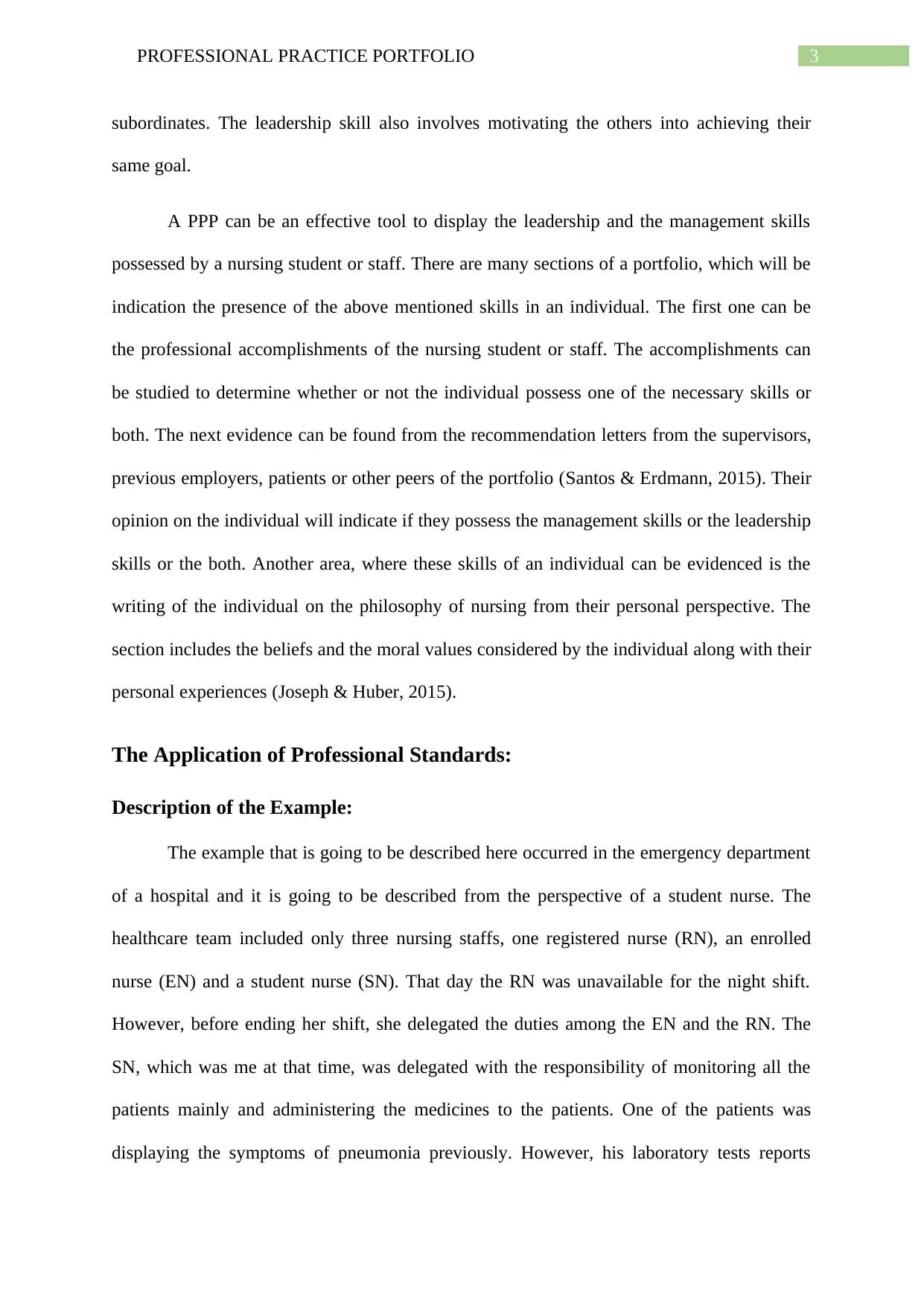
3PROFESSIONAL PRACTICE PORTFOLIO
subordinates. The leadership skill also involves motivating the others into achieving their
same goal.
A PPP can be an effective tool to display the leadership and the management skills
possessed by a nursing student or staff. There are many sections of a portfolio, which will be
indication the presence of the above mentioned skills in an individual. The first one can be
the professional accomplishments of the nursing student or staff. The accomplishments can
be studied to determine whether or not the individual possess one of the necessary skills or
both. The next evidence can be found from the recommendation letters from the supervisors,
previous employers, patients or other peers of the portfolio (Santos & Erdmann, 2015). Their
opinion on the individual will indicate if they possess the management skills or the leadership
skills or the both. Another area, where these skills of an individual can be evidenced is the
writing of the individual on the philosophy of nursing from their personal perspective. The
section includes the beliefs and the moral values considered by the individual along with their
personal experiences (Joseph & Huber, 2015).
The Application of Professional Standards:
Description of the Example:
The example that is going to be described here occurred in the emergency department
of a hospital and it is going to be described from the perspective of a student nurse. The
healthcare team included only three nursing staffs, one registered nurse (RN), an enrolled
nurse (EN) and a student nurse (SN). That day the RN was unavailable for the night shift.
However, before ending her shift, she delegated the duties among the EN and the RN. The
SN, which was me at that time, was delegated with the responsibility of monitoring all the
patients mainly and administering the medicines to the patients. One of the patients was
displaying the symptoms of pneumonia previously. However, his laboratory tests reports
subordinates. The leadership skill also involves motivating the others into achieving their
same goal.
A PPP can be an effective tool to display the leadership and the management skills
possessed by a nursing student or staff. There are many sections of a portfolio, which will be
indication the presence of the above mentioned skills in an individual. The first one can be
the professional accomplishments of the nursing student or staff. The accomplishments can
be studied to determine whether or not the individual possess one of the necessary skills or
both. The next evidence can be found from the recommendation letters from the supervisors,
previous employers, patients or other peers of the portfolio (Santos & Erdmann, 2015). Their
opinion on the individual will indicate if they possess the management skills or the leadership
skills or the both. Another area, where these skills of an individual can be evidenced is the
writing of the individual on the philosophy of nursing from their personal perspective. The
section includes the beliefs and the moral values considered by the individual along with their
personal experiences (Joseph & Huber, 2015).
The Application of Professional Standards:
Description of the Example:
The example that is going to be described here occurred in the emergency department
of a hospital and it is going to be described from the perspective of a student nurse. The
healthcare team included only three nursing staffs, one registered nurse (RN), an enrolled
nurse (EN) and a student nurse (SN). That day the RN was unavailable for the night shift.
However, before ending her shift, she delegated the duties among the EN and the RN. The
SN, which was me at that time, was delegated with the responsibility of monitoring all the
patients mainly and administering the medicines to the patients. One of the patients was
displaying the symptoms of pneumonia previously. However, his laboratory tests reports
Paraphrase This Document
Need a fresh take? Get an instant paraphrase of this document with our AI Paraphraser
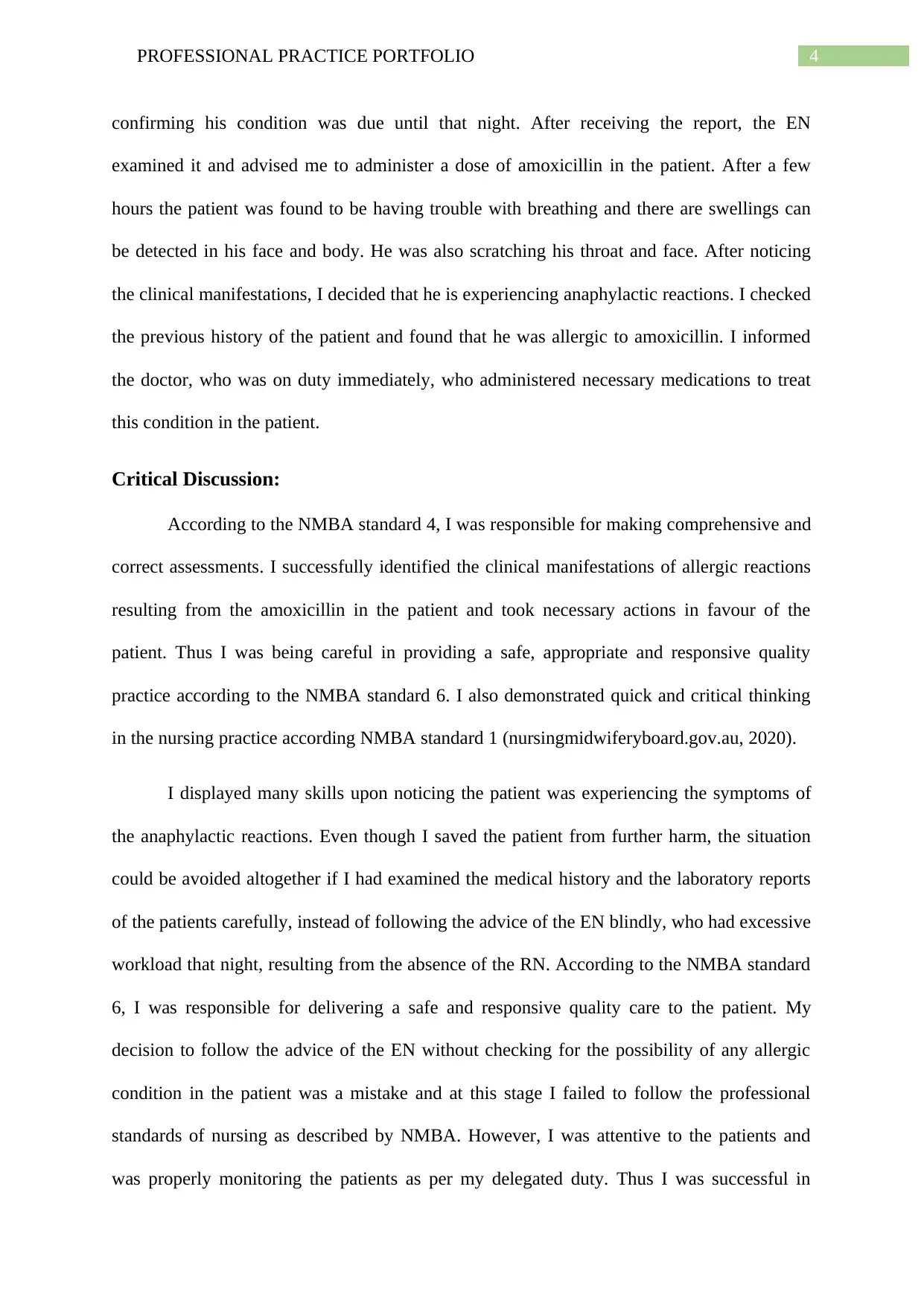
4PROFESSIONAL PRACTICE PORTFOLIO
confirming his condition was due until that night. After receiving the report, the EN
examined it and advised me to administer a dose of amoxicillin in the patient. After a few
hours the patient was found to be having trouble with breathing and there are swellings can
be detected in his face and body. He was also scratching his throat and face. After noticing
the clinical manifestations, I decided that he is experiencing anaphylactic reactions. I checked
the previous history of the patient and found that he was allergic to amoxicillin. I informed
the doctor, who was on duty immediately, who administered necessary medications to treat
this condition in the patient.
Critical Discussion:
According to the NMBA standard 4, I was responsible for making comprehensive and
correct assessments. I successfully identified the clinical manifestations of allergic reactions
resulting from the amoxicillin in the patient and took necessary actions in favour of the
patient. Thus I was being careful in providing a safe, appropriate and responsive quality
practice according to the NMBA standard 6. I also demonstrated quick and critical thinking
in the nursing practice according NMBA standard 1 (nursingmidwiferyboard.gov.au, 2020).
I displayed many skills upon noticing the patient was experiencing the symptoms of
the anaphylactic reactions. Even though I saved the patient from further harm, the situation
could be avoided altogether if I had examined the medical history and the laboratory reports
of the patients carefully, instead of following the advice of the EN blindly, who had excessive
workload that night, resulting from the absence of the RN. According to the NMBA standard
6, I was responsible for delivering a safe and responsive quality care to the patient. My
decision to follow the advice of the EN without checking for the possibility of any allergic
condition in the patient was a mistake and at this stage I failed to follow the professional
standards of nursing as described by NMBA. However, I was attentive to the patients and
was properly monitoring the patients as per my delegated duty. Thus I was successful in
confirming his condition was due until that night. After receiving the report, the EN
examined it and advised me to administer a dose of amoxicillin in the patient. After a few
hours the patient was found to be having trouble with breathing and there are swellings can
be detected in his face and body. He was also scratching his throat and face. After noticing
the clinical manifestations, I decided that he is experiencing anaphylactic reactions. I checked
the previous history of the patient and found that he was allergic to amoxicillin. I informed
the doctor, who was on duty immediately, who administered necessary medications to treat
this condition in the patient.
Critical Discussion:
According to the NMBA standard 4, I was responsible for making comprehensive and
correct assessments. I successfully identified the clinical manifestations of allergic reactions
resulting from the amoxicillin in the patient and took necessary actions in favour of the
patient. Thus I was being careful in providing a safe, appropriate and responsive quality
practice according to the NMBA standard 6. I also demonstrated quick and critical thinking
in the nursing practice according NMBA standard 1 (nursingmidwiferyboard.gov.au, 2020).
I displayed many skills upon noticing the patient was experiencing the symptoms of
the anaphylactic reactions. Even though I saved the patient from further harm, the situation
could be avoided altogether if I had examined the medical history and the laboratory reports
of the patients carefully, instead of following the advice of the EN blindly, who had excessive
workload that night, resulting from the absence of the RN. According to the NMBA standard
6, I was responsible for delivering a safe and responsive quality care to the patient. My
decision to follow the advice of the EN without checking for the possibility of any allergic
condition in the patient was a mistake and at this stage I failed to follow the professional
standards of nursing as described by NMBA. However, I was attentive to the patients and
was properly monitoring the patients as per my delegated duty. Thus I was successful in
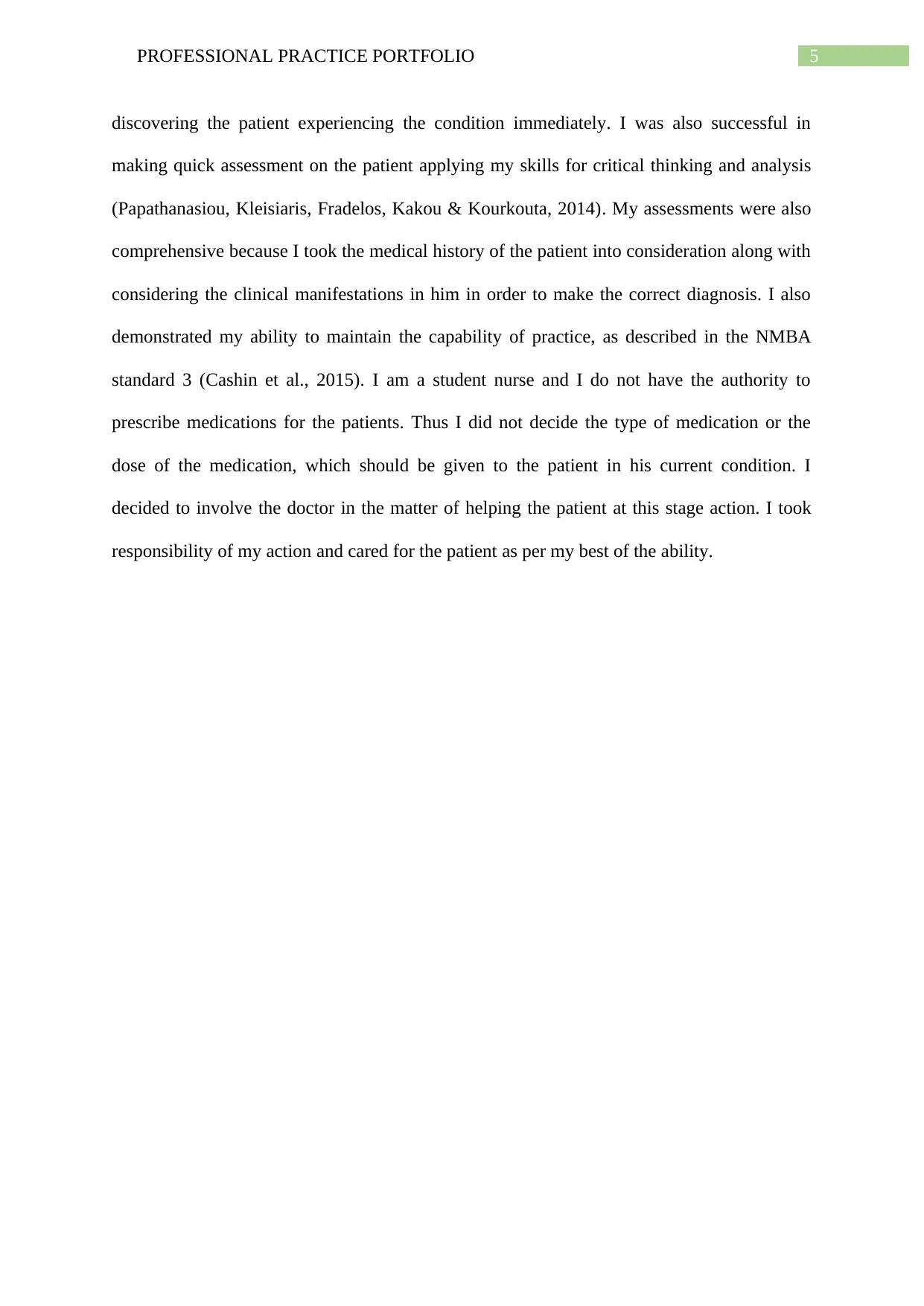
5PROFESSIONAL PRACTICE PORTFOLIO
discovering the patient experiencing the condition immediately. I was also successful in
making quick assessment on the patient applying my skills for critical thinking and analysis
(Papathanasiou, Kleisiaris, Fradelos, Kakou & Kourkouta, 2014). My assessments were also
comprehensive because I took the medical history of the patient into consideration along with
considering the clinical manifestations in him in order to make the correct diagnosis. I also
demonstrated my ability to maintain the capability of practice, as described in the NMBA
standard 3 (Cashin et al., 2015). I am a student nurse and I do not have the authority to
prescribe medications for the patients. Thus I did not decide the type of medication or the
dose of the medication, which should be given to the patient in his current condition. I
decided to involve the doctor in the matter of helping the patient at this stage action. I took
responsibility of my action and cared for the patient as per my best of the ability.
discovering the patient experiencing the condition immediately. I was also successful in
making quick assessment on the patient applying my skills for critical thinking and analysis
(Papathanasiou, Kleisiaris, Fradelos, Kakou & Kourkouta, 2014). My assessments were also
comprehensive because I took the medical history of the patient into consideration along with
considering the clinical manifestations in him in order to make the correct diagnosis. I also
demonstrated my ability to maintain the capability of practice, as described in the NMBA
standard 3 (Cashin et al., 2015). I am a student nurse and I do not have the authority to
prescribe medications for the patients. Thus I did not decide the type of medication or the
dose of the medication, which should be given to the patient in his current condition. I
decided to involve the doctor in the matter of helping the patient at this stage action. I took
responsibility of my action and cared for the patient as per my best of the ability.
⊘ This is a preview!⊘
Do you want full access?
Subscribe today to unlock all pages.

Trusted by 1+ million students worldwide
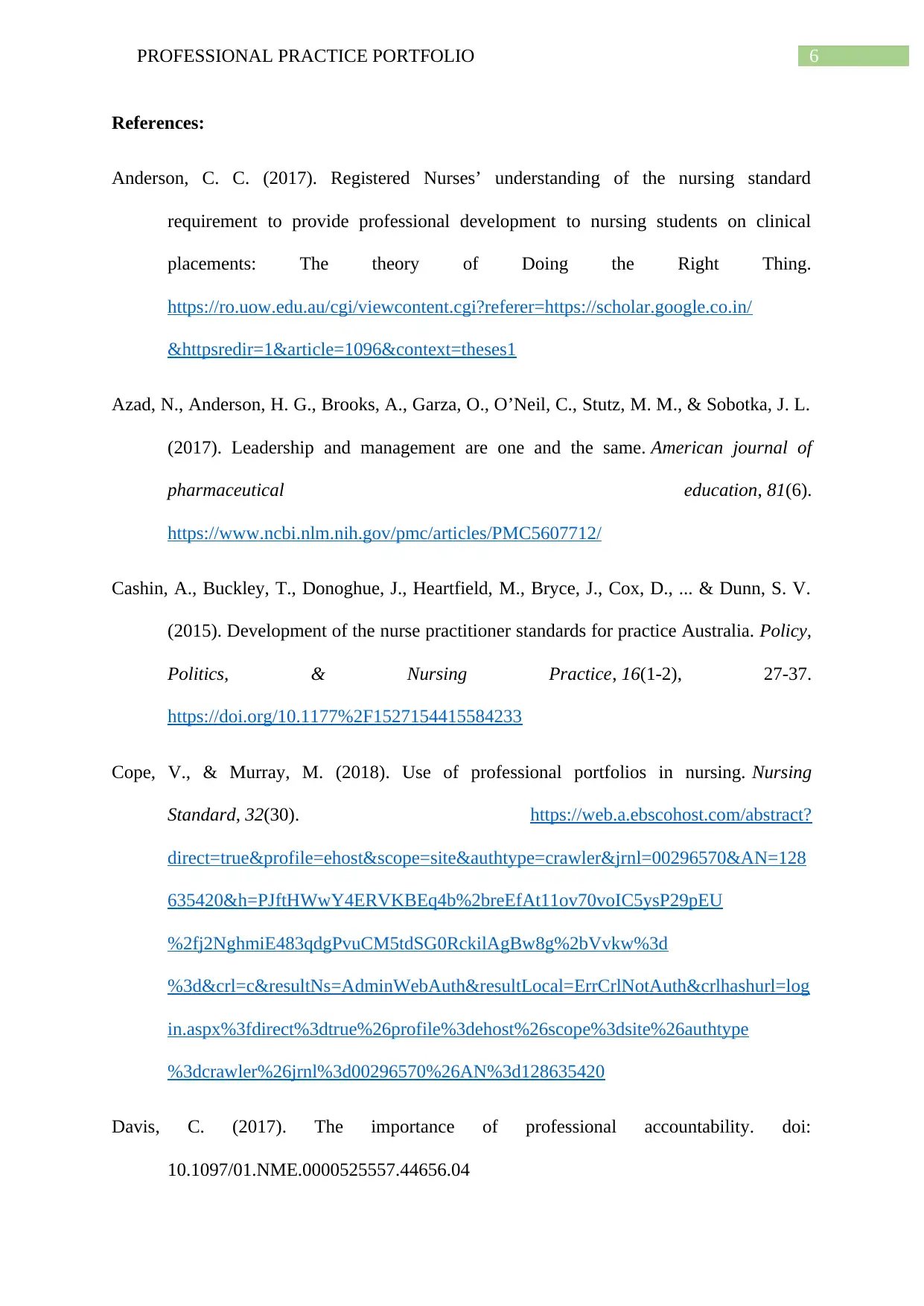
6PROFESSIONAL PRACTICE PORTFOLIO
References:
Anderson, C. C. (2017). Registered Nurses’ understanding of the nursing standard
requirement to provide professional development to nursing students on clinical
placements: The theory of Doing the Right Thing.
https://ro.uow.edu.au/cgi/viewcontent.cgi?referer=https://scholar.google.co.in/
&httpsredir=1&article=1096&context=theses1
Azad, N., Anderson, H. G., Brooks, A., Garza, O., O’Neil, C., Stutz, M. M., & Sobotka, J. L.
(2017). Leadership and management are one and the same. American journal of
pharmaceutical education, 81(6).
https://www.ncbi.nlm.nih.gov/pmc/articles/PMC5607712/
Cashin, A., Buckley, T., Donoghue, J., Heartfield, M., Bryce, J., Cox, D., ... & Dunn, S. V.
(2015). Development of the nurse practitioner standards for practice Australia. Policy,
Politics, & Nursing Practice, 16(1-2), 27-37.
https://doi.org/10.1177%2F1527154415584233
Cope, V., & Murray, M. (2018). Use of professional portfolios in nursing. Nursing
Standard, 32(30). https://web.a.ebscohost.com/abstract?
direct=true&profile=ehost&scope=site&authtype=crawler&jrnl=00296570&AN=128
635420&h=PJftHWwY4ERVKBEq4b%2breEfAt11ov70voIC5ysP29pEU
%2fj2NghmiE483qdgPvuCM5tdSG0RckilAgBw8g%2bVvkw%3d
%3d&crl=c&resultNs=AdminWebAuth&resultLocal=ErrCrlNotAuth&crlhashurl=log
in.aspx%3fdirect%3dtrue%26profile%3dehost%26scope%3dsite%26authtype
%3dcrawler%26jrnl%3d00296570%26AN%3d128635420
Davis, C. (2017). The importance of professional accountability. doi:
10.1097/01.NME.0000525557.44656.04
References:
Anderson, C. C. (2017). Registered Nurses’ understanding of the nursing standard
requirement to provide professional development to nursing students on clinical
placements: The theory of Doing the Right Thing.
https://ro.uow.edu.au/cgi/viewcontent.cgi?referer=https://scholar.google.co.in/
&httpsredir=1&article=1096&context=theses1
Azad, N., Anderson, H. G., Brooks, A., Garza, O., O’Neil, C., Stutz, M. M., & Sobotka, J. L.
(2017). Leadership and management are one and the same. American journal of
pharmaceutical education, 81(6).
https://www.ncbi.nlm.nih.gov/pmc/articles/PMC5607712/
Cashin, A., Buckley, T., Donoghue, J., Heartfield, M., Bryce, J., Cox, D., ... & Dunn, S. V.
(2015). Development of the nurse practitioner standards for practice Australia. Policy,
Politics, & Nursing Practice, 16(1-2), 27-37.
https://doi.org/10.1177%2F1527154415584233
Cope, V., & Murray, M. (2018). Use of professional portfolios in nursing. Nursing
Standard, 32(30). https://web.a.ebscohost.com/abstract?
direct=true&profile=ehost&scope=site&authtype=crawler&jrnl=00296570&AN=128
635420&h=PJftHWwY4ERVKBEq4b%2breEfAt11ov70voIC5ysP29pEU
%2fj2NghmiE483qdgPvuCM5tdSG0RckilAgBw8g%2bVvkw%3d
%3d&crl=c&resultNs=AdminWebAuth&resultLocal=ErrCrlNotAuth&crlhashurl=log
in.aspx%3fdirect%3dtrue%26profile%3dehost%26scope%3dsite%26authtype
%3dcrawler%26jrnl%3d00296570%26AN%3d128635420
Davis, C. (2017). The importance of professional accountability. doi:
10.1097/01.NME.0000525557.44656.04
Paraphrase This Document
Need a fresh take? Get an instant paraphrase of this document with our AI Paraphraser
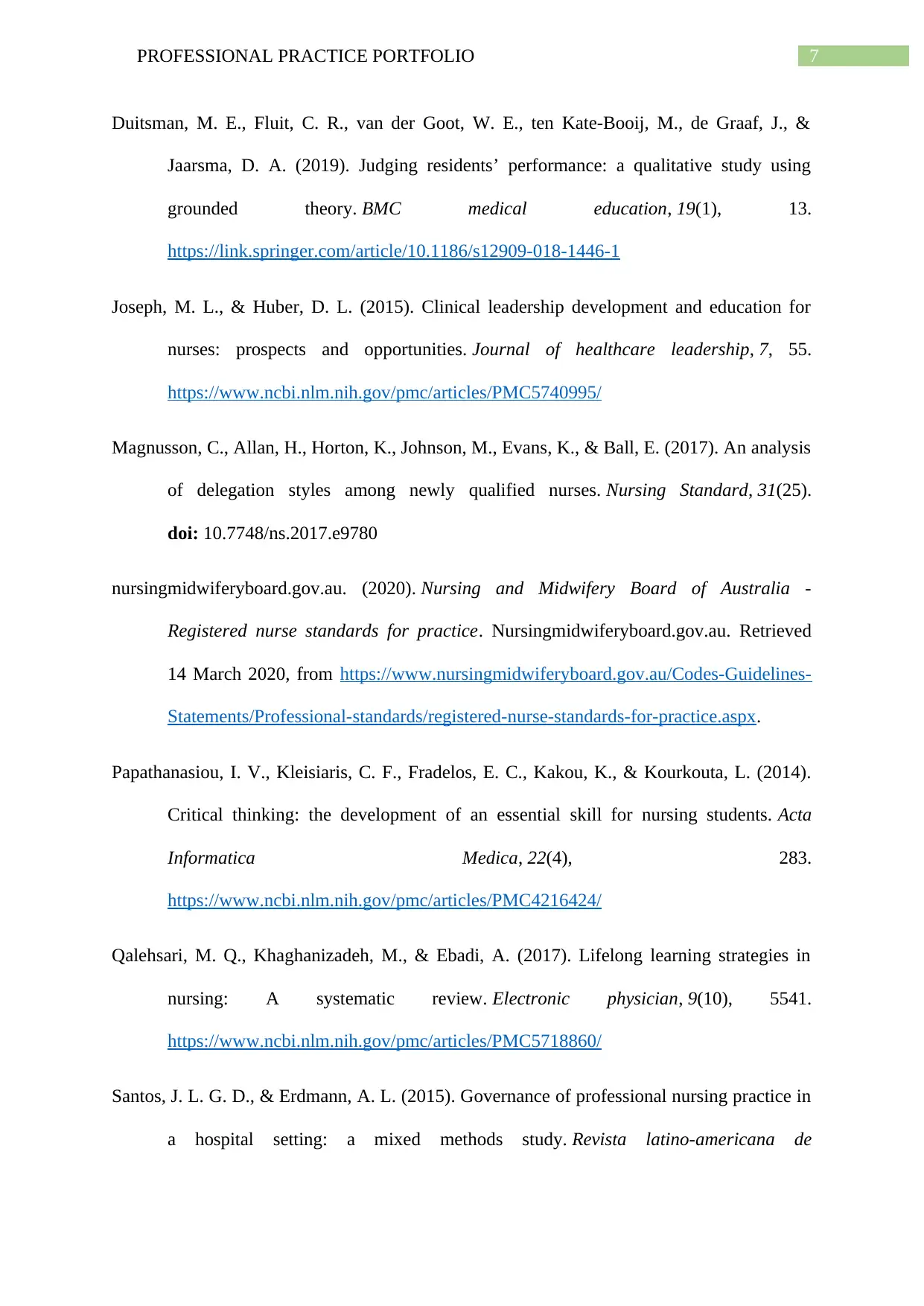
7PROFESSIONAL PRACTICE PORTFOLIO
Duitsman, M. E., Fluit, C. R., van der Goot, W. E., ten Kate-Booij, M., de Graaf, J., &
Jaarsma, D. A. (2019). Judging residents’ performance: a qualitative study using
grounded theory. BMC medical education, 19(1), 13.
https://link.springer.com/article/10.1186/s12909-018-1446-1
Joseph, M. L., & Huber, D. L. (2015). Clinical leadership development and education for
nurses: prospects and opportunities. Journal of healthcare leadership, 7, 55.
https://www.ncbi.nlm.nih.gov/pmc/articles/PMC5740995/
Magnusson, C., Allan, H., Horton, K., Johnson, M., Evans, K., & Ball, E. (2017). An analysis
of delegation styles among newly qualified nurses. Nursing Standard, 31(25).
doi: 10.7748/ns.2017.e9780
nursingmidwiferyboard.gov.au. (2020). Nursing and Midwifery Board of Australia -
Registered nurse standards for practice. Nursingmidwiferyboard.gov.au. Retrieved
14 March 2020, from https://www.nursingmidwiferyboard.gov.au/Codes-Guidelines-
Statements/Professional-standards/registered-nurse-standards-for-practice.aspx.
Papathanasiou, I. V., Kleisiaris, C. F., Fradelos, E. C., Kakou, K., & Kourkouta, L. (2014).
Critical thinking: the development of an essential skill for nursing students. Acta
Informatica Medica, 22(4), 283.
https://www.ncbi.nlm.nih.gov/pmc/articles/PMC4216424/
Qalehsari, M. Q., Khaghanizadeh, M., & Ebadi, A. (2017). Lifelong learning strategies in
nursing: A systematic review. Electronic physician, 9(10), 5541.
https://www.ncbi.nlm.nih.gov/pmc/articles/PMC5718860/
Santos, J. L. G. D., & Erdmann, A. L. (2015). Governance of professional nursing practice in
a hospital setting: a mixed methods study. Revista latino-americana de
Duitsman, M. E., Fluit, C. R., van der Goot, W. E., ten Kate-Booij, M., de Graaf, J., &
Jaarsma, D. A. (2019). Judging residents’ performance: a qualitative study using
grounded theory. BMC medical education, 19(1), 13.
https://link.springer.com/article/10.1186/s12909-018-1446-1
Joseph, M. L., & Huber, D. L. (2015). Clinical leadership development and education for
nurses: prospects and opportunities. Journal of healthcare leadership, 7, 55.
https://www.ncbi.nlm.nih.gov/pmc/articles/PMC5740995/
Magnusson, C., Allan, H., Horton, K., Johnson, M., Evans, K., & Ball, E. (2017). An analysis
of delegation styles among newly qualified nurses. Nursing Standard, 31(25).
doi: 10.7748/ns.2017.e9780
nursingmidwiferyboard.gov.au. (2020). Nursing and Midwifery Board of Australia -
Registered nurse standards for practice. Nursingmidwiferyboard.gov.au. Retrieved
14 March 2020, from https://www.nursingmidwiferyboard.gov.au/Codes-Guidelines-
Statements/Professional-standards/registered-nurse-standards-for-practice.aspx.
Papathanasiou, I. V., Kleisiaris, C. F., Fradelos, E. C., Kakou, K., & Kourkouta, L. (2014).
Critical thinking: the development of an essential skill for nursing students. Acta
Informatica Medica, 22(4), 283.
https://www.ncbi.nlm.nih.gov/pmc/articles/PMC4216424/
Qalehsari, M. Q., Khaghanizadeh, M., & Ebadi, A. (2017). Lifelong learning strategies in
nursing: A systematic review. Electronic physician, 9(10), 5541.
https://www.ncbi.nlm.nih.gov/pmc/articles/PMC5718860/
Santos, J. L. G. D., & Erdmann, A. L. (2015). Governance of professional nursing practice in
a hospital setting: a mixed methods study. Revista latino-americana de
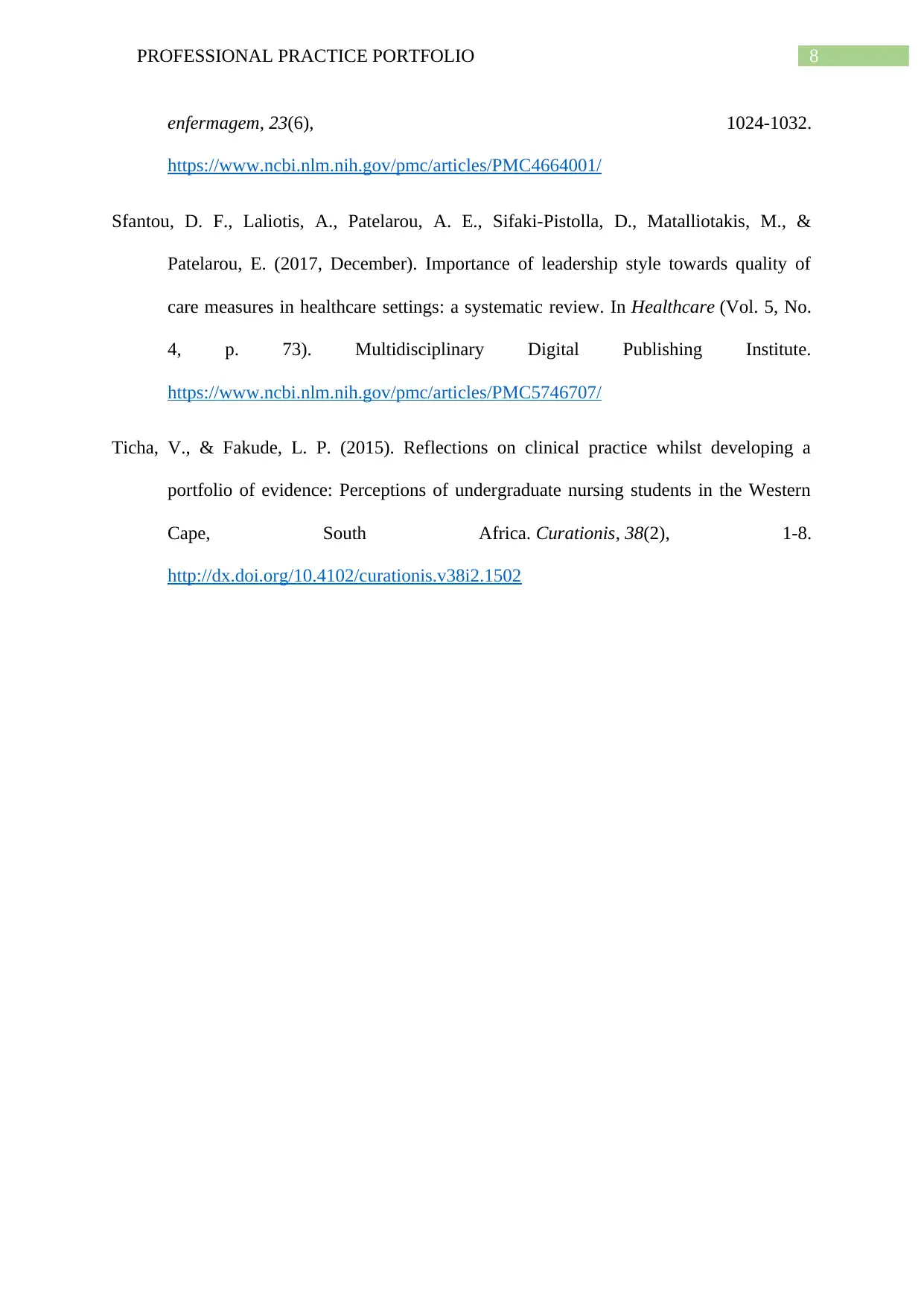
8PROFESSIONAL PRACTICE PORTFOLIO
enfermagem, 23(6), 1024-1032.
https://www.ncbi.nlm.nih.gov/pmc/articles/PMC4664001/
Sfantou, D. F., Laliotis, A., Patelarou, A. E., Sifaki-Pistolla, D., Matalliotakis, M., &
Patelarou, E. (2017, December). Importance of leadership style towards quality of
care measures in healthcare settings: a systematic review. In Healthcare (Vol. 5, No.
4, p. 73). Multidisciplinary Digital Publishing Institute.
https://www.ncbi.nlm.nih.gov/pmc/articles/PMC5746707/
Ticha, V., & Fakude, L. P. (2015). Reflections on clinical practice whilst developing a
portfolio of evidence: Perceptions of undergraduate nursing students in the Western
Cape, South Africa. Curationis, 38(2), 1-8.
http://dx.doi.org/10.4102/curationis.v38i2.1502
enfermagem, 23(6), 1024-1032.
https://www.ncbi.nlm.nih.gov/pmc/articles/PMC4664001/
Sfantou, D. F., Laliotis, A., Patelarou, A. E., Sifaki-Pistolla, D., Matalliotakis, M., &
Patelarou, E. (2017, December). Importance of leadership style towards quality of
care measures in healthcare settings: a systematic review. In Healthcare (Vol. 5, No.
4, p. 73). Multidisciplinary Digital Publishing Institute.
https://www.ncbi.nlm.nih.gov/pmc/articles/PMC5746707/
Ticha, V., & Fakude, L. P. (2015). Reflections on clinical practice whilst developing a
portfolio of evidence: Perceptions of undergraduate nursing students in the Western
Cape, South Africa. Curationis, 38(2), 1-8.
http://dx.doi.org/10.4102/curationis.v38i2.1502
⊘ This is a preview!⊘
Do you want full access?
Subscribe today to unlock all pages.

Trusted by 1+ million students worldwide
1 out of 9
Related Documents
Your All-in-One AI-Powered Toolkit for Academic Success.
+13062052269
info@desklib.com
Available 24*7 on WhatsApp / Email
![[object Object]](/_next/static/media/star-bottom.7253800d.svg)
Unlock your academic potential
Copyright © 2020–2025 A2Z Services. All Rights Reserved. Developed and managed by ZUCOL.





